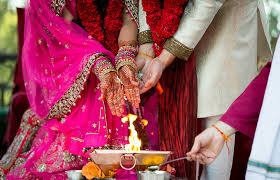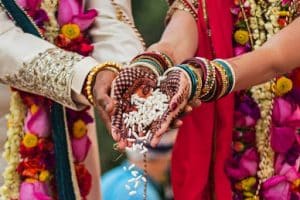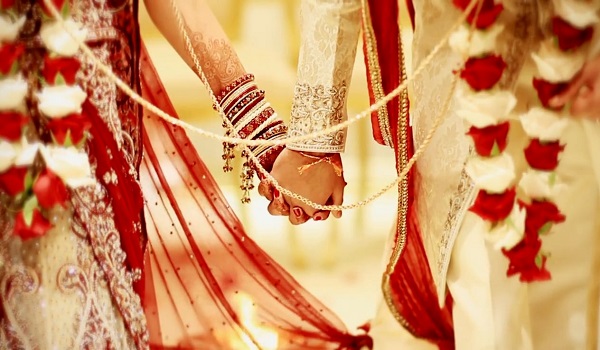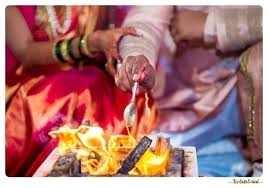
Weddings are a celebration of love and commitment, and can also be a celebration of the couple’s religion and culture. One such ceremony that you might not be so familiar with? A Hindu wedding ceremony. “Hindu weddings culturally unite two souls spiritually, mentally, and physically. The marriage is not only a celebration of two people coming to be unified but rather the merging of two families,” explains event planner Jignasa Patel. “In modern times this is more evident as a wedding lies somewhere between the couple’s expectations while blending their family traditions. With many rituals and mini ceremonies leading to the main ceremony day, it binds the couple and both families for eternity.”
Hindu weddings are vibrant, intricately-planned, culture-rich festivities full of celebration and tradition. Whether you’re invited as a guest, attending as a member of the wedding party, or are simply curious, there are a few Hindu wedding rituals and traditions you should expect to see. Just remember, you won’t be alone. “An intimate Hindu wedding can consist of an average of about 150-200 guests,” says Patel. “Based on some castes in Hindu families, you don’t only invite friends and family but at times the entire community from your hometown. This number can lead into the thousands, even in the U.S.”
- What should I wear to a Hindu wedding? It’s common for guests to wear traditional Indian clothes like saris or lenghas for women and long-sleeved tunics and pants for men. “Consider wearing traditional Indian attire with beadwork and embroidery to as many events as possible,” advises Patel. “Hindu weddings are very glamorous and lavish, and this means dressing the part will create an unforgettable experience. Build each event outfit as if you were outdoing yourself from the last event, saving your most glamorous outfit for the day of the wedding ceremony and reception.” If you decide to go with a more western option, remember that women should have their shoulders, legs, and occasionally arms covered. Men should wear long sleeves and long pants. Both men and women need to bring something to cover their heads during the ceremony. Bold, vibrant colors are heavily encouraged but be sure to stay away from white (associated with funerals), black (considered unlucky), and red as this is the color the bride wears.
- How long is a Hindu wedding? The events of a Hindu wedding normally take place over the span of three days with different events taking place on each day. The main ceremony and reception on the third day, as well as the sangeet during the second day, are attended by most of the guests. The ganesh pooja ceremony that commences the wedding events on the first day is usually an intimate event with only close family in attendance. “Be prepared for early morning events,” advises Patel. “Hindu wedding celebrations are based on auspicious times predetermined and provided by the priest.”
- Will the newlyweds kiss? Traditionally there is no kiss at the end of a Hindu wedding ceremony as a result of the predominantly conservative culture. However, this varies greatly on the couples themselves, as well as their families, in which case a kiss exchange has been known to take place.
- Will there be alcohol? “It’s important for attendees to know that there is no alcohol served or brought to the Hindu wedding ceremony,” says Patel. “The ceremony is impactful in many religious traditions and customs starting at one-and-a-half hours leading into a three-hour-long ceremony.”
- Should I bring a gift? Gifts are usually not brought to a ceremony, though this can vary. If you intend to gift something to the couple, have it shipped to their home. The only exception is if you intend to present them with a monetary gift, in which case this would be given in an envelope at the wedding reception.
#01 The Wedding Date Is Determined in the StarsBefore the wedding, an auspicious time (known as the muhurta) is fixed for the event. Using the couple’s dates of birth, astrologists calculate the position of planets and stars to reflect the celestial union of the couple. During the ceremony, the gotra of both to-be-weds’ (going back at least three generations) are announced. A gotra is the ancestral lineage or the ancestor’s original clan (this is not related to caste or religion). In Hindu law, marriages should not take place within the same clan.#02 There’s a Pre-Party Called the Sangeet a Few Days Before the WeddingPrior to the actual wedding, there’s a pre-party called the sangeet or garba (depending on the regional background) where family comes together to sing, dance, and revel in the joy of the upcoming union. Family members even give performances. The bride’s family sings a traditional folk song to the groom’s family to welcome them. The sangeet, which translates to “sung together,” takes place on the same day as the mehndi ceremony that kicks off the wedding itself.#03 The Bride’s Hands and Feet Are Adorned With Henna Paint During a Mehndi CeremonyDuring the mehndi ceremony, which also takes place in Muslim weddings, henna is used to apply intricate designs of temporary decorative art to the bride’s hands and feet. “In my experience, I have learnt that there are several Hindu beliefs that the henna is indicative of during a wedding,” says Patel. “Each of these beliefs is based on the colour of the henna; the first one, which is what I learnt from my family, is that the darker the henna, the more a mother-in-law will be fond of her daughter-in-law. Others that I have come to learn through working with Hindus from different regions state that the darker the henna, the stronger the marriage or the more the husband will love the wife.”
“As this is mostly decorative art intended to beautify the bride, we often chose floral designs,” adds Patel. “However, another common tradition is to hide the groom’s name somewhere in the henna design and have the groom find it. We all love this tradition as it is really fun to watch the groom study the intricate design on his bride and it is believed to show how much patience the couple will have.” The mehndi ceremony usually takes place one day before the marriage will be held, as the application can take hours. This event is traditionally only attended by the bride’s close female friends and family members.
#04 The Bride Wears a Red Dress
The bride’s garments will be red (also the case for Muslim brides). “Traditionally a South Asian bride will wear a red sari or a modern lengha to be wrapped in on her wedding day,” says Patel. “The beautiful patterns and richness of the color with gold embroidery in her outfit symbolize commitment and fertility.”
#05 The Groom’s Arrival Is a Celebration in Itself
The arrival of the groom and his party to the ceremony site, called the vara yatra or baraat, is celebrated with great joy. “While the bride’s guests arrive at the destination and are directed straight to the hall, the groom’s guests need to be prepared to join the baraat procession which will enter with the groom,” explains Patel. “This means that upon arrival, the groom’s guests will be redirected to join the ‘mini parade’ instead of going straight to the hall. The baraat is personally one of my favorite parts of Hindu weddings as it is such a fun experience with music and dance, and the groom’s side has such a great time!”
They are greeted by the bride’s parents, family, and friends amidst live music and dancing. The party is welcomed with a special rice toss, known as akshat, and the groom is presented with a plate carrying a lit lamp (or arati), and a garland. Sometimes a tilak, or dot on the forehead, is also administered.
#06 The Father of the Bride Gives Her Away
The bride will be led to the ceremony by either her brothers or uncles. The moment the father gives the bride away is known as the kanyadaan. In the Hindu tradition, no man can claim a woman until she is offered. During the ceremony, the father of the bride places his daughter’s hands into the groom’s hands as a gesture of giving her away.
#07 The Couple Weds Under a Mandap
The wedding mandap, or wedding altar, is a temporary structure constructed for the purpose of the marriage ceremony. It may appear on an elevated platform and is decorated with anything from flowers and greenery to fabric and crystals. The couple is traditionally joined beneath the mandap by their parents
#08 A Fire Burns in the Center of the Mandap
In the center of the mandap, a fire is kindled. A Hindu marriage is a sacrament, not a contract. To signify the viability of the ceremony, fire is kept as a witness and offerings are made. The bride’s brother gives three fistfuls of puffed rice to the bride as a wish for his sister’s happy marriage. Each time, the bride offers the rice to the fire. This offering is known as a homam.
#09 Hindu Wedding Rituals Begin With a Prayer to Ganesha
The ceremony begins with a prayer to Ganesha, the god of beginnings and good fortune and the remover of obstacles. Salutations are offered so that Ganesha may pave the way for the couple’s married life.
#10 The Couple Exchanges Floral Garlands During the Jai Mala
“A jai mala is a flower garland that is exchanged between the bride and groom,” explains Patel. “To us Hindus, the jai mala symbolizes the partners welcoming each other into their families and takes place after the Ganesha. Without it, we do not consider a marriage to be complete.” In the U.S. or other fusion weddings, the ring ceremony usually follows.
#11 The Groom Adorns the Bride With a Necklace Called the Mangala Sutra
The groom places a necklace of black and gold beads on the bride. Traditionally, Lakshmi, the Hindu goddess of wealth, fortune, and prosperity, is invoked in the mangala sutra and the bride is said to receive blessings throughout her marriage.
#12 The Bride and Groom’s Garments Are Tied Together as They Circle a Fire
The saptapadi is an important ritual in North Indian Hindu weddings. During the saptapadi, the bride and groom have their garments tied together—typically the bride’s veil and the groom’s sash. In South India, the couple walks seven steps together to signify their friendship. In North Indian tradition, they make seven circles around a ceremonial fire, each round signifying a specific blessing they request of the gods. The main significance of the saptapadi is establishing friendship, which is the basis of a Hindu marriage.
#13 The Newlyweds Shower Each Other With Rice
In a South Indian custom called the talambralu, or ritual of happiness, the couple showers one another with a mixture of rice, turmeric, saffron, and even pearls. This tradition symbolizes fertility, prosperity, and happiness.
#14 Red Powder (Sindoor) Is Applied to the Bride’s Hair, Signifying She Is MarriedSindoor, a red-orange powder, is applied to the part of a woman’s hair, symbolizing her new status as a married woman once the ceremony is complete.#15 The Couple’s Sendoff Is an Emotional Vidaai Ceremony“Not all brides’ farewells end with sparklers and smiles,” says Patel. “As a Hindu bride officially leaves her home to start a new life with her husband, the goodbyes are heartwarming and tearful during the Vidaai ceremony. She walks away spreading happiness and prosperity by taking handfuls of rice and coins to be directly thrown over her head to show her appreciation for the time and love given to her in the home of her parents.” The Vidaai ceremony is the symbolic end of the wedding festivities and characterized by the bride’s parents giving a final farewell to their daughter.Credits to – https://www.brides.com/hindu-wedding-ceremony-rituals-traditions-4795869

Marriages, according to Hindu beliefs are made in heaven, and once you are married, the bond is supposed to last for seven lifetimes. It is considered to be a turning point in an individual’s life as he enters the second important phase or ashram of his life – the ‘Garhasthyaashram’. A lot of importance is associated with marriages in Hinduism as it is considered to be one of the most important duties of a man’s life. Through marriage he is paying his debt to his forefathers, by procreating children and ensuring continuation of his family’s lineage. Hindu weddings are long processes, with various rituals that may take days to be executed. Every single custom and practice in a wedding ceremony has deep philosophical and spiritual significance. Throughout the world the Hindus adhere to these set of rituals and continue on the traditions of marriage that is unique amongst those in the world.
Types of Weddings
According to Hindu sacred texts like Asvalayana Garhyasutra and Atharvaveda, eight different types of marriages are recognized by the ancient Hindu society. Four of them were categorized as ‘Prashasta’ or proper marriages conducted by following appropriate religious customs. The remaining four were considered as ‘Aprashasta’, which referred to inappropriate unions between man and woman that did not follow any Vedic or religious ritual.
The various types of Prashasta marriages are as follows –
Brahma– It is the marriage that takes place upon receiving mutual consent from both bride and groom’s families. It is considered the most appropriate form of marriage in Hindu society.
Daiva – The daughter is dressed up with fine clothes and ornaments and is offered as a sacrifice fee to the Deity. This type of weddings was prevalent during yajna sacrifices in ancient times.
Arsha – The father gives away his daughter in exchange for a cow and a bull from the groom’s family. The groom takes an oath to effectuate his commitment towards the bride and her family.
Prajapatya – Here the couple get married by uttering Sanskrit verses promising eternal love in presence of their families. This is similar to a modern day civil ceremony where neither priest nor religious rites are performed.
The various types of Aprashasta marriages are –
Gandharva – The bride and the groom either start living together as a couple out of love and mutual consent or get married without a formal ceremony as well as without the consent of their families.
Asura – In this type of marriage, the bride’s father has been intimidated or bribed by the groom or his family into giving his consent to giving up his daughter for marriage.
Rakshasha – In these types of marriage the bride is forced into marrying against her consent.
Paisacha – This is the most brutal of all types of marriages, where the groom forces himself upon the bride first and then accepts her as his bride.
The last two types of marriages were not only indecorous but also religiously impermissible.
Hindu marriages are based on age old traditions that have been translated into laws. According to traditions, a Hindu marriage cannot be reversed and is irrevocable. The modern day Hindu Marriage laws prohibit Polygamy or Polyandry. In India as well as most Hindu cultures across the world, arranged marriages are still the most preferred way of getting hitched. Consent and happiness of the families are of utmost important in Hindu culture as the marriage not only union of two souls, but also union of two families.
Variations in Hindu Weddings across India
Weddings among Hindus in India are a set of complex customs and vary considerably from region to region. Each community has their own spin on the basic Hindu wedding ceremony based on geographical location and cultural influences. While in some communities, it is a simple but elegant affair, in others, weddings spell grandeur and pomp. In North India the wedding proceedings are generally termed as ‘Vivah Sanskar’ whereas in most of South India it is referred to as ‘Kalyanam’. Hindu weddings are basically a Yajna ritual with the Fire Deity or Agni as the primary witness. The rituals are primarily handled and carried out along with Sanskrit Mantras, according to guidelines laid down thousands of years ago by sages who created the Vedas. In some cultures weddings take place during daytime, while in others they are held only after sunset. In some communities like the Kerala Nairs weddings are matrilineal instead of patriarchal which the norm is almost everywhere else. While most north Indian weddings are big on fun, frolic and colors, weddings in South India are comparatively demure and modest.
Although, there are countless variations across the country when it comes to wedding rituals, but among most Hindu communities, weddings are elaborate events with multiple rituals being observed throughout many days. The common theme of all different versions is the fervor along with a proclivity towards adherence to traditions. Also involvement of the extended family and friends are must in Indian Hindu weddings. There are certain common pre-wedding, wedding day and post-wedding customs that are generally observed by all Hindus.
Pre-wedding Rituals
As arranged marriages are still the primary mode of marriage among Hindu, pre-wedding ceremonies are directed towards finding the perfect match by a prospective bride or groom’s families. That is either through a family friend or a professional matchmaker, or from a modern perspective through matrimonial sites. Even in the context where the couples who are going for a love marriage, the two families are to be introduced to each other and agree upon the finer points of the impending union. Most communities stress upon a horoscope matching before proceeding further in an arranged marriage. If the stars of the boy and girl are in perfect harmony, then the marriage talks proceed further. The two families meet to discuss the finer details of the impending event. A date is fixed when the formal announcement of the wedding will take place. This is generally known as the Engagement ceremony.
The engagement ceremony is known by many names – Sagai in Haryana, Roka in Punjab, Sakhar Puda in Maharashtra, Kasamdry among Kashmiri Pandits, Tilak among Marwaris, Nishchayam or Nishchaya Thamboolam in South India and Ghor Dana among Gujaratis. Exchange of rings may take place in some cultures between the bride and groom-to be. But there is almost always an exchange of gifts between the two families symbolizing acceptance of the match and as a gesture of welcoming into each other’s families. In most cases, the date of the wedding is decided on the day of the engagement ceremony. Generally there is a gap of a few months between the engagement and the wedding for the families to prepare for the big day. As the wedding day approaches, there are a few rituals that are observed like Ganesh Puja, Mehendi, Sangeet and Haldi.
In most cultures, a Puja is held by both the bride and groom’s families. The families pray to Lord Ganesha to remove all obstacles from the couple’s life path.
Mehendi is mostly a North Indian tradition where a paste of henna is applied on the bride’s and groom’s hands. For the bride the designs are intricate, elaborate and artistic. Women in the family gathers and get henna designs applied to their hands as well. Nowadays other cultures like Bengalis and South Indians have also adopted this tradition of applying Mehendi before wedding. The Sangeet is a fun-filled ceremony where both the families get together to perform song-dance routines, and get to know each other better. This is a predominantly North Indian practice as well, especially among Punjabis and Gujaratis, but has been widely adopted by other cultures as well. The Haldi ceremony is a very common ritual among almost all communities in India. Turmeric is ground to a paste along with other ingredients that vary from culture to culture. This paste in applied to both the bride’s and groom at their respective places by women elderly members of their families before they are washed by sacred water. The Haldi Ceremony is known by many a name across the country, Gaye Holud among Bengalis, Pithi among Gujaratis and Mangala Snanam among Tamilians.
Wedding Rituals
The key steps of Hindu wedding ritual are Kanyadaan and Paanigrahan, Vivaah Homa, Laja Homa and Agni Pradakshina, and finally Saptapadi according to Grihya sutras. Other rituals vary according to regional cultures but these are the key steps of a Hindu Marriage without which the marriage would not be considered complete. Traditionally, the bride’s parents host the wedding ceremony and the groom and his family are the guests arriving from outside to the Mandap. The whole wedding ceremony sort of depicts a story of first meeting of the bride and the groom at the wedding mandap, the bride’s parents giving her away to this worthy man, the couple committing to each other in front of the sacred fire followed by the couple taking the seven vows of commitment to the marriage and the friends and families blessing the newly wedded couple.
The groom arrives at the bride’s house and he is welcomed by the bride’s parents first with an arti, then by feeding a drink of milk and honey known as Madhu Parka ceremony and finally before he arrives at the mandap the bride’s father washes the groom’s feet. The bride arrives at the mandap and the couple lay their eyes on each other. These rituals are presented in various forms among different Indian communities.
The father of the bride then gives her away to the groom in a ceremony known as Kanyadaan. The left hand of the bride is placed on the groom’s right hand and the bride’s parents utter the following words while giving her away ‘Today, the bride is Laxmi and the groom is Vishnu. By joining their hands in marriage, we will repay the debt to our forefathers by continuing the next life cycle.’ Kanyadaan is considered to be the noblest act of offering that a person can perform and by doing it the parents of the bride are absolved of all their bad karmas. The groom accepts the bride’s hand and they promise each other that while pursuing a life of Dharma, Artha and Kama, they will remain faithful to each other. This is known as Paanigrahan.
Next the sacred fire is lit at the center of the wedding mandap and is considered to be the prime witness of the marriage rituals. The couple feed ghee to the fire as offering and prays to the Gods for Santati (children), Sampatti (wealth & prosperity) and Deergharogya (long and healthy lives). This is known as the Vivaha Homa. During the Laja Homa, the bride’s brother pours rice on her palms and the couple offers it to the sacred fire together. The ends of their garments are tied in a knot and they perform Agni Pradakshina where they make seven circles around the Sacred Fire uttering the promise to each other to be eternal partners and complement each other in life’s journey. At the end of the seventh circle the bride moves to the left side of the groom indicating that she is now part of his life. The final most important ritual in a Hindu Wedding is the Saptapadi or the Seven Sacred Vows. The bride takes seven symbolic steps while pushing a stone along the floor with her left foot while the groom assists her. They reiterate the aspirations of their married life as each step signifies a specific promise that the couple make to each other which are as follows –
- First step: To respect and honor each other
- Second step: To share each other’s joy and sorrow
- Third step: To trust and be loyal to each other
- Fourth step: To cultivate appreciation for knowledge, values, sacrifice and service
- Fifth step: To appreciate purity of emotions, love, family duties and spiritual growth
- Sixth step: To follow principles of Dharma
- Seventh step: To nurture an eternal bond of friendship and love
On completion of this ritual the marriage is concluded and the couple seeks blessings from elders of the families.
The post wedding rituals primarily comprises of Vidaai, welcoming of the bride at the groom’s house and reception. During the Vidaai ceremony the family of the bride gives her an emotional send-off and the bride throws back three handfuls of rice and coin over her shoulders to signify end of her debt to her parents for nurturing her and wishing prosperity upon them.
On the arrival at the groom’s house, the new couple is welcomed by the groom’s mother, with a traditional aarti. The bride enters her in-laws house by displacing a container filled with rice signifying that she is the bringer of abundance to her new family. She then dips her feet in a mixture of red vermillion and enters the house, leaving foot prints on the floor. This ritual is practiced as the bride is considered as a form of Goddess Laxmi. After this, a number of wedding games are played to make the bride comfortable.
A reception is either organized by the bride’s family after the wedding rituals have been completed to feed guest and get them to bless the couple. Or in some cultures it is arranged by the groom’s family after the bride has arrived from her paternal home.
Credits to – https://www.culturalindia.net/weddings/regional-weddings/hindu-wedding.html
Please consider Donating to keep our culture alive



